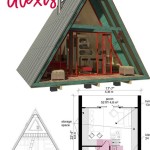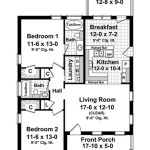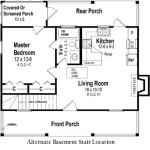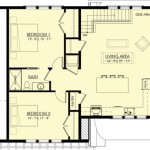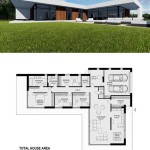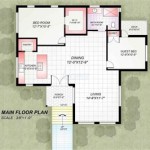Basic Ranch House Floor Plans: An Overview
Ranch house floor plans, characterized by their single-story design and open layouts, remain a popular choice for homeowners seeking accessibility, functionality, and a connection to the outdoors. Their inherent simplicity allows for easy customization and adaptation to various needs and preferences. Understanding the fundamentals of basic ranch house floor plans is crucial for both prospective buyers and those considering renovating an existing property.
The defining characteristic of a ranch house is its single-story construction. This eliminates the need for stairs, making it an ideal choice for individuals with mobility limitations, families with young children, or those simply preferring a single-level living space. The horizontal orientation of the ranch house also contributes to its visual appeal, lending to a sense of groundedness and stability. While some ranch houses may incorporate basements, the primary living areas are invariably located on the ground floor.
Originally popularized in the mid-20th century, ranch houses were designed to embrace the informality and casual lifestyle that emerged in post-war America. The emphasis was placed on creating a seamless flow between interior spaces and outdoor living areas. Large windows and sliding glass doors were incorporated to maximize natural light and provide easy access to patios, gardens, and yards. This connection to the outdoors remains a key selling point for ranch-style homes.
Key Point 1: Common Layouts and Room Arrangements
Basic ranch house floor plans typically feature a linear or L-shaped layout, often with a central hallway providing access to the various rooms. Variations like the U-shaped ranch are also encountered, particularly in larger properties. The placement of rooms is typically organized for efficiency and convenience. The living room, often the largest space, may be located at the front of the house, offering a welcoming entry point. Bedrooms are commonly grouped together in a separate wing for privacy and quiet.
The kitchen in a ranch house floor plan is frequently situated near the dining area, facilitating easy meal preparation and service. Open-concept designs, where the kitchen flows directly into the living or dining room, are increasingly prevalent in modern ranch house adaptations. This arrangement promotes social interaction and allows for a more inclusive living experience. Islands and peninsulas are often incorporated in open kitchens to provide additional counter space and seating.
Bathrooms are typically located near the bedrooms for ease of access. Ranch houses may feature one or two full bathrooms, along with a smaller half-bath or powder room for guests. En suite bathrooms, connected directly to the master bedroom, are also common, offering a private retreat for homeowners. The size and configuration of bathrooms can vary significantly depending on the overall size and design of the house.
Garages are often attached to the house, providing convenient access for vehicles and storage. Attached garages may be located at the front, side, or rear of the property, depending on the lot size and orientation. Some ranch houses also include carports, which offer covered parking but without the full enclosure of a garage. The inclusion of a garage or carport is a practical consideration for homeowners, particularly in regions with inclement weather.
Utility rooms, housing essential appliances such as the washing machine, dryer, and water heater, are typically located near the kitchen or garage. These rooms are often designed for functionality rather than aesthetics, and may include storage space for cleaning supplies and other household items. The placement of the utility room can impact the overall flow and convenience of the house.
Key Point 2: Typical Room Sizes and Dimensions
The size of rooms in a basic ranch house floor plan can vary depending on the overall square footage of the house and the specific design choices made by the architect or builder. However, some generalizations can be made regarding typical room dimensions. Living rooms in ranch houses often range from 16 feet by 20 feet to 20 feet by 24 feet, providing ample space for seating and entertainment. Bedrooms may average 12 feet by 14 feet, offering sufficient space for a bed, dresser, and other furniture. Master bedrooms are typically larger, ranging from 14 feet by 16 feet to 16 feet by 18 feet.
Kitchen sizes vary depending on whether the kitchen is a separate room or part of an open-concept design. In a separate kitchen, the dimensions may range from 10 feet by 12 feet to 12 feet by 16 feet. Open kitchens, integrated with the living or dining room, may occupy a larger overall space, effectively blending the kitchen area with the adjacent room. The inclusion of an island or peninsula will further influence the dimensions of the kitchen area.
Bathrooms in ranch houses typically range from 5 feet by 8 feet to 8 feet by 10 feet, depending on the layout and features. En suite bathrooms may be larger, incorporating additional amenities such as a separate shower and tub. Half-baths or powder rooms are usually smaller, often measuring around 3 feet by 6 feet.
The overall square footage of a basic ranch house can range from 1,000 square feet to 2,500 square feet, depending on the number of bedrooms and bathrooms, the size of the living areas, and the inclusion of features such as a garage or finished basement. Larger ranch houses may offer more spacious rooms and additional amenities, while smaller ranch houses may prioritize efficiency and affordability.
Ceiling heights in ranch houses typically range from 8 feet to 9 feet. Higher ceilings can create a more spacious and airy feel, while lower ceilings may contribute to a sense of coziness. Vaulted ceilings, which slope upward from the walls, are also sometimes incorporated in ranch house designs, adding visual interest and enhancing the sense of space.
Key Point 3: Considerations for Accessibility and Aging in Place
The single-story design of ranch houses makes them inherently more accessible than multi-story homes. The absence of stairs eliminates a significant barrier for individuals with mobility limitations, such as those using wheelchairs or walkers. Wider doorways and hallways can further enhance accessibility, allowing for easier navigation throughout the house.
Ramp access can be incorporated at entry points to eliminate the need for steps. Ramps should have a gentle slope to ensure ease of use. Alternatively, platform lifts can be installed to provide vertical access to raised entryways. The addition of grab bars in bathrooms can also improve safety and stability for individuals with mobility challenges.
Lever-style door handles are easier to operate than traditional doorknobs, particularly for individuals with arthritis or limited hand strength. Rocker-style light switches are also more accessible than traditional toggle switches. These simple modifications can significantly improve the usability of the house for people of all ages and abilities.
Roll-under sinks and countertops can be incorporated in the kitchen and bathrooms to accommodate wheelchair users. Adjustable-height countertops can also be installed to provide flexibility for individuals with varying needs. These features promote inclusivity and ensure that the house can adapt to the changing needs of its occupants.
Walk-in showers with low thresholds or no thresholds are safer and more accessible than traditional bathtubs with high sides. Handheld showerheads offer greater control and flexibility. Non-slip flooring can further reduce the risk of falls in the bathroom. These modifications can significantly enhance the safety and comfort of the bathroom for individuals of all ages.
Adequate lighting is essential for creating a safe and accessible environment. Bright, even lighting can improve visibility and reduce the risk of accidents. Under-cabinet lighting in the kitchen can illuminate work surfaces, while motion-sensor lighting can provide automatic illumination in hallways and bathrooms. Properly placed lighting can significantly enhance the safety and usability of the house, particularly for older adults.
The adaptability of basic ranch house floor plans makes them a desirable option for those planning for aging in place. Designing with future needs in mind ensures that the house remains comfortable and functional for years to come. Incorporating accessibility features from the outset can prevent the need for costly renovations later on. The investment in accessibility and universal design principles can significantly enhance the long-term value and livability of a ranch house.
In conclusion, understanding the common layouts, dimensions, and accessibility considerations of ranch house floor plans is essential for making informed decisions about buying, building, or renovating a property. The inherent simplicity and flexibility of the ranch style make it a popular choice for homeowners seeking comfort, functionality, and a connection to the outdoors.

Simple House Plans Google Search Ranch Style Floor

Ranch House Plans With Open Floor Blog Homeplans Com

Ranch House Plans Traditional Floor

4 Bedroom Classic Ranch House Plan With Covered Porch

Simple To Build Ranch Home Plan 81317w Architectural Designs House Plans

Simple Ranch House Plans Houseplans Blog Com

Ranch Style House Plan 3 Beds 2 Baths 1494 Sq Ft 1010 23 One Floor Plans New

1400 Sq Ft Simple Ranch House Plan Affordable 3 Bed 2 Bath Floor Plans Style

Trending Ranch Style House Plans With Open Floor Blog Eplans Com

1 400 Square Foot Modular Ranch Home Three Bedrooms And Two Full Bathrooms Signature Building Systems

